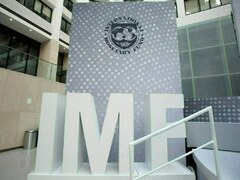IMF Forecasts Steady Growth for Pakistan in FY25
ISLAMABAD: Pakistan’s economic expansion is projected to remain relatively stable in fiscal year 2025, according to the International Monetary Fund (IMF). However, this reflects a slight downward adjustment of 0.6 percentage points from the prior forecast in October. This revision is mainly due to subdued economic activity in the initial half of FY25 and amplified trade uncertainties. These factors outweigh the anticipated positive effects of recent and further monetary easing measures expected later in the fiscal year.
In its latest “Regional Development and Economic Outlook” report, the IMF projects GDP growth at 2.6 percent for fiscal year 2025 and 3.6 percent for 2026, compared to 2.5 percent in fiscal year 2024.
The report indicates that inflation is expected to continue its downward trend in 2025 and subsequent years, aligning with global patterns. This decrease is attributed to favorable base effects (Egypt, Pakistan), decreased pressures from commodity and food prices (Morocco), and the delayed impact of tightened monetary policy (Egypt).
The IMF Executive Board is scheduled to discuss the Pakistan program on May 9.
Regional Economic Divergence
Current growth patterns reveal a difference between oil-exporting and oil-importing economies in the Middle East and North Africa (MENA) region, including Pakistan.
In 2024, most oil exporters successfully navigated a complex economic landscape, supported by ongoing diversification efforts, despite reduced oil activity stemming from extended OPEC+ voluntary production cuts. Conversely, ongoing conflicts in the MENA region and their knock-on effects have negatively impacted growth in several oil-importing economies.
Looking ahead, economic activity in the MENA region and Pakistan is still projected to gain momentum, but at a slower pace than previously anticipated in October. This slowdown reflects the consequences of escalating global trade tensions and heightened uncertainty, compounded by a more gradual resumption of oil production, a slower resolution of regional conflicts, and slower progress on structural reforms, particularly in Egypt.
Moreover, the potential for renewed inflationary pressures could lead to a prolonged period of elevated interest rates amid widening sovereign spreads in the region. This scenario would particularly affect several MENA emerging market and middle-income countries, including Pakistan, due to their high debt levels.
Fiscal consolidation is anticipated to proceed at a moderate pace, driven by ongoing efforts to decrease public debt. However, borrowing costs are expected to remain high for many MENA EM&MIs and Pakistan, with effective interest rates projected to stay above pre-pandemic averages.
Although sovereign spreads on external debt have narrowed across EM&MIs—albeit widening substantially for highly-indebted economies amid rising global trade policy uncertainty—maturing debt would likely require refinancing at higher yields in countries such as Egypt, Jordan, Pakistan, and Tunisia.
With interest rates projected to remain elevated for an extended duration, countries grappling with substantial debt levels and financing needs, particularly Egypt, Jordan, Pakistan, and Tunisia, will need to accelerate fiscal consolidation. This can be achieved through controlling subsidy spending and generating additional revenue, including through the elimination of tax exemptions and enhanced tax administration. Policymakers should also mitigate risks associated with contingent liabilities arising from large state-owned enterprises (Egypt, Pakistan) and public-private partnerships (Morocco).
Fiscal positions continued to strengthen in oil importers not affected by ongoing conflicts, including Mauritania, Morocco, Pakistan, Somalia, and Tunisia.
The primary balance in these economies improved by an average of 1.4 percent of GDP in 2024 compared to 2023, supported by effective measures to increase tax revenues through policy and administration reforms, as well as efforts to streamline spending, including subsidy reductions (Morocco, Pakistan). In Pakistan, increased interest expenses, which rose by approximately 0.9 percent of GDP compared to the previous year, dampened the consolidation efforts.
In the Middle East and North Africa (MENA) and Caucasus and Central Asia (CCA) regions, the tariffs announced in April were set high—between 20 and 40 percent — for countries such as Algeria, Iraq, Jordan, Kazakhstan, Libya, Pakistan, Syria, and Tunisia, while others were set at the baseline rate of 10 percent.
For most economies in the MENA and CCA regions, the impact is less than 1 percent. However, pending further discussions and agreements, the effects on Pakistan and Jordan could be more significant given their larger shares of exports to the United States in their total exports.
Tunisia experienced benefits from consistent tourism revenues and remittances, Pakistan saw increased agricultural production and an economic recovery following the 2023 floods, and Mauritania’s non-extractive sectors demonstrated strong performance.



Comments (0)
No comments yet. Be the first to comment!
Leave a Comment